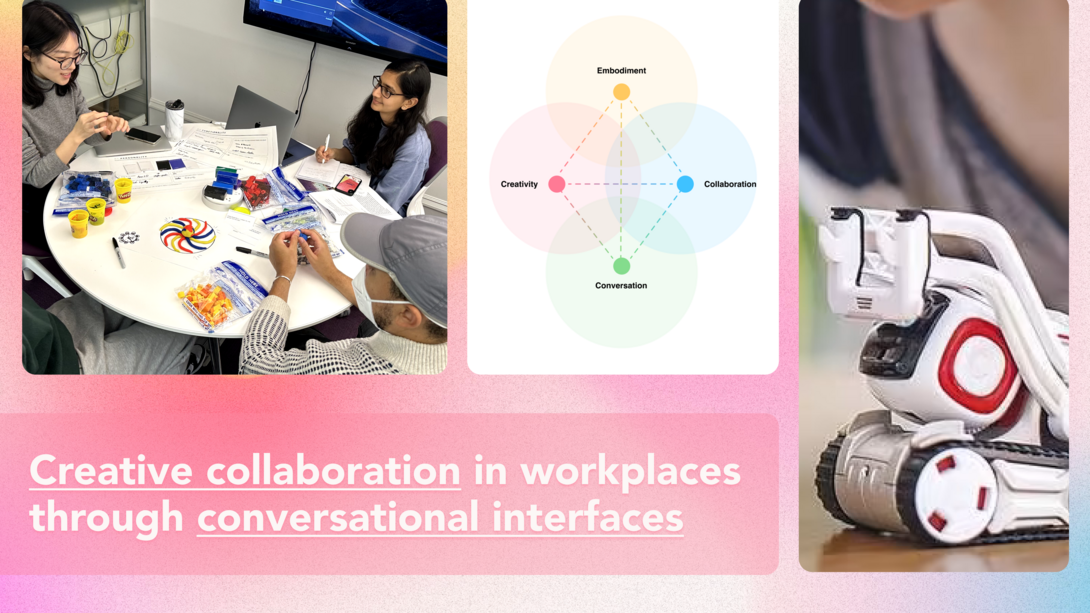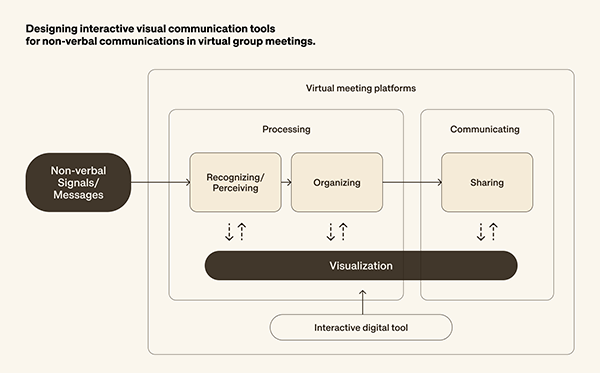Three MDes Students Awarded 2023 kynamatrix Research Grants
At the start of 2023, Carnegie Mellon University's School of Design students Anupriya Gupta, Elaine Lu, and Youngryun Cho were awarded kynamatrix Research Network's "Innovation through Collaboration" grants for projects in design, engineering, and computer science. The kynamatrix Research Network is a nonprofit network of researchers dedicated to the "understanding and advancement of interactive communication, accelerating innovation in design, engineering, and computer science." The award is granted yearly and encourages studies in "interactive communication across the academic disciplines of design, engineering, and computer science."
The winning projects, along with their abstracts, were:
Creative collaboration in workplaces through conversational interfaces
Anupriya Gupta (MDes '23)
Faculty Advisor: Dina El-Zanfaly and Paul Pangaro
Embodied conversational interfaces are becoming increasingly popular in home environments. A recent research report in 2020 found that more than 60 million Americans, or nearly 24%, above 18 years of age own at least one smart speaker in their homes. These interfaces are currently being used for various purposes ranging from social engagement, services, increasing productivity, and educational and learning purposes, but these use cases are largely limited by 1:1 interaction with very few to no explorations with multi-user interactions. Given that creativity and collaboration will be the top two most sought skills for the next era in organizations, the aim of the project is to facilitate and enable collaboration and creativity in a work setting with the focus on students' collaboration through embodied conversational interfaces. Gupta's project aims to answer the research question - How can embodied conversational interfaces empower creative collaboration amongst design students in a group work environment? By undertaking this study now, when embodied conversational interfaces have not yet become popular in workspaces, there is a scope to consciously design technology, form guiding framework and drive interaction strategy decisions rather than technological constraints driving design decisions.

Design methods for AI/ML innovation
Elaine Lu (MDes '23)
Faculty Advisors: Bruce Hanington and John Zimmerman
According to Gartner, 85% of AI and Machine Learning (ML) projects fail, and only 53% of projects make it from prototype to production. One of the top reasons is that AI projects fail to deliver promised benefits or returns. This is often due to lack of sufficient quality data, lack of model iteration over time, overpromising AI capabilities, and underestimating time and cost of projects. Today, most AI features are designed by Research Engineers who know the current state of the art of AI and ML. Designers are often invited onto projects after the choice of what to build has already been made. Designers also struggle to gain an understanding of what AI can do, often envisioning AI features that cannot be built. Yet, designers are uniquely positioned to inspire teams to rally around humane user experiences that are desirable by customers. So how can Designers best work with cross functional partners and technologists to develop AI features that are also buildable? Lu's thesis shares a proposal for a design intervention that will change the way designers work with AI, in order to move toward improving the success rate of AI projects.

Designing interactive visual communication tools for non-verbal communications in virtual group meetings
Youngryun Cho (MDes '23)
Faculty Advisors: Ashley Deal and Raelynn O'Leary
This thesis project started from curiosity about how visual languages could help communication to help people better understand each other. Non-verbal signals other than verbal language deliver a lot of information, but the ability to recognize, regulate and communicate them is different for every people. A theory of Emotional Intelligence provides how psychologists define and measure competencies in perceiving emotions, regulating emotions, and coping effectively with emotive situations. (Zeidner et al, 2009) Based on Emotional Intelligence, Cho's thesis project explores an opportunity where visualization of emotions could benefit how we communicate with each other for better relationships.

The kynamatrix Research Network, co-founded by School of Design alumna Alyce Hoggan (MDes ’00), operates collaboratively through two programs: research & grant gifting. These two programs work together to achieve their mission of solving real-world problems.